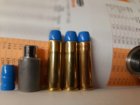Start at your 15.0gr charge and load 6 rounds, and then decrease the powder charge by 0.5gr and load another 6 rounds...continue until you reach 10.0gr of powder.
I am tempted to test this, but i think NOT.
Start at your 15.0gr charge and load 6 rounds, and then decrease the powder charge by 0.5gr and load another 6 rounds...continue until you reach 10.0gr of powder.



I am tempted to test this, but i think NOT.
When I did a load study for shooting IDPA using a S&W 686 (4" barrel), I determined that .38 Special was the better case size. For my purposes I didn't need to max out velocity and I would struggle to burn a full case of powder lone enough the extra case capacity of a 357 Magnum case. I tested W231, TiteGroup, Bulleye, TrailBoss, Clays, CFE Pistol. Keep in mind that my goal was accuracy and serviceability at a preset velocity (750fps). I needed the gun to stay relatively clean so that I could shoot a 200 - 300 round match without the pistol or chamber getting gummed up and impairing the speed loading and ejection of the cylinder rapidly and multiple times during a stage. I didn't want to be cleaning a gun during a match... so Unique Powder and majority of shotgun type powders were immediately disqualified
Cleanest to Dirtiest: Trail Boss (winner), Bullseye & TiteGroup (very close 2nd & 3rd), CFE Pistol, W231 2nd dirtiest, and Clays was the worst (all shotgun powders are dirty).
Recoil least to worst: Trail Boss was noticeably milder then all. Bulleye and TiteGroup were both more snappy, and TiteGroup also had a tendency to nose flip. The others were somewhere in the middle.
Case Fill to achieve the same target velocity: Trail Boss (+60%... clear winner). Both Bulleye and Titegroup had the least amount of case fill of approximately 20%...huge risk of double or triple charge.
No one gives Case Fill enough credence. The lesson was hammered into me a few year ago while RSO an IDPA practice in which one of our expert shooters detonated his 44 Mag. This really changed my philosophy on larger classic cartridges that were originally designed around either black powder or early powders that had larger volume and lower explosive energy. I started paying more attention to case fill as a safety measure and reloading requirement especially when using modern powders that are very fast burning. What I learned during my load development process is that you can't see a 20% case fill unless you hover directly over the case and look down into it. This potential issue becomes greater when loading on a progressive press. If you have a hiccup during your rotation then just pay a lot of attention to make certain you don't double charge a case when you reset the shell holder after fixing the issue.
I had one of those and it never produced the crimp I was looking to get. I got an RCBS seat/crimp die, removed the seating stem and use it as a dedicated roll crimp die. By keeping an eye on case length and making slight adjustments to the crimp depending on the bullet I'm using. I use plus+ or minus- .001" from recommended trim to lengths, and my crimps are consistent from shell to shell. For jacketed bullets a crimp consistent enough to grip in the cannelure is dependent on case length. For hard cast lead a bullet with a deep crimp groove, case length is a little more forgiving. For plated bullets with no cannelure or crimp groove, I use a taper crimp die. Some kind of a crimp is needed even if it's little more that just to remove the belling at the case mouth. Most powders work at their best at or close to the maximum charge weights, by that I mean they burn their cleanest and some powders are position sensitive also.So is there a "problem" per say of continuing to use these loads? Its sporadic, not every case. 1 in 4 or 5 I would say. Which kind of makes me think it's a crimp issue. I use the Lee factory Crimp Die set to touch the shell holder then tightened 1/2 turn beyond that.
LC

